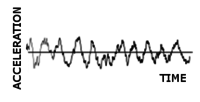Random vibration

Random vibration is like shaking a box full of toys, but you never know how it's going to shake. Imagine you have a toy box with lots of different toys inside. If you shake the box up and down, side to side, or in circles, some toys might move more than others. But you can't predict which toys will move the most or in which direction. That's because the shake is random, which means it's unpredictable.
Now, imagine that instead of a toy box, you have a machine or a building. Sometimes, these things get shaken too, but not by someone deliberately shaking them. It could be because of the wind, an earthquake, or just normal use. We call this random vibration because we can't predict how the shaking is going to affect the machine or building. It could cause some parts to move more than others, or it could cause some parts to break.
To make sure machines and buildings can handle random vibration, engineers test them by shaking them in different directions with different frequencies and intensities. They do this in a controlled environment, using special equipment that can replicate the vibrations that might happen in real life. This way, they can see how well the machine or building can withstand repeated random vibrations and make any necessary adjustments to make sure they're safe and reliable.
Now, imagine that instead of a toy box, you have a machine or a building. Sometimes, these things get shaken too, but not by someone deliberately shaking them. It could be because of the wind, an earthquake, or just normal use. We call this random vibration because we can't predict how the shaking is going to affect the machine or building. It could cause some parts to move more than others, or it could cause some parts to break.
To make sure machines and buildings can handle random vibration, engineers test them by shaking them in different directions with different frequencies and intensities. They do this in a controlled environment, using special equipment that can replicate the vibrations that might happen in real life. This way, they can see how well the machine or building can withstand repeated random vibrations and make any necessary adjustments to make sure they're safe and reliable.
Related topics others have asked about:
